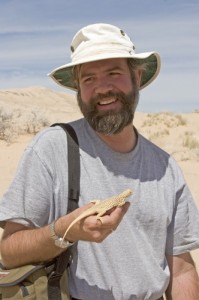 |
Sliding Rocks of Racetrack Playa—Rock Movement without aliens or giant magnets, just floating ice and light windsRichard Norris Wednesday, October 29th, 2014 |
||
|
|||
| ABSTRACT
An enduring mystery in Geology is why and how rocks move of their own accord over a nearly flat, mud-cracked lake bed in Death Valley National Park–the Racetrack Playa. We set up the “Slithering Stones Research Initiative” and installed a weather station on the Racetrack. We also outfitted 15 rocks with GPS loggers to record when rocks moved, how fast they went and where they went. This past December, Jim Norris and I saw them go. Our GPS instrumented stones moved as much as 224 m at a pace of 2-6 m/minute. This occurred in a shallow ice-covered pond that formed in November 2013 and lasted through mid February, 2014. Rocks moved at least 5 times during this period and perhaps as many as 9 times. The mechanisms is the force of a thin (2-4 mm) thick sheet of floating ice being moved by light (3-5 m/sec) winds near mid day. Sun on the floating ice sheet and wind stress causes the ~1km-wide ice sheet to breakup, driving rocks across the lake bed for 12-20 minutes before the ice has become too fragmented to move stones. Satellite observations suggest the phenomenon is probably widespread on playa lakes (although highly episodic) but most lakes to don’t have a large supply of stones to form rock trails. |
|||

